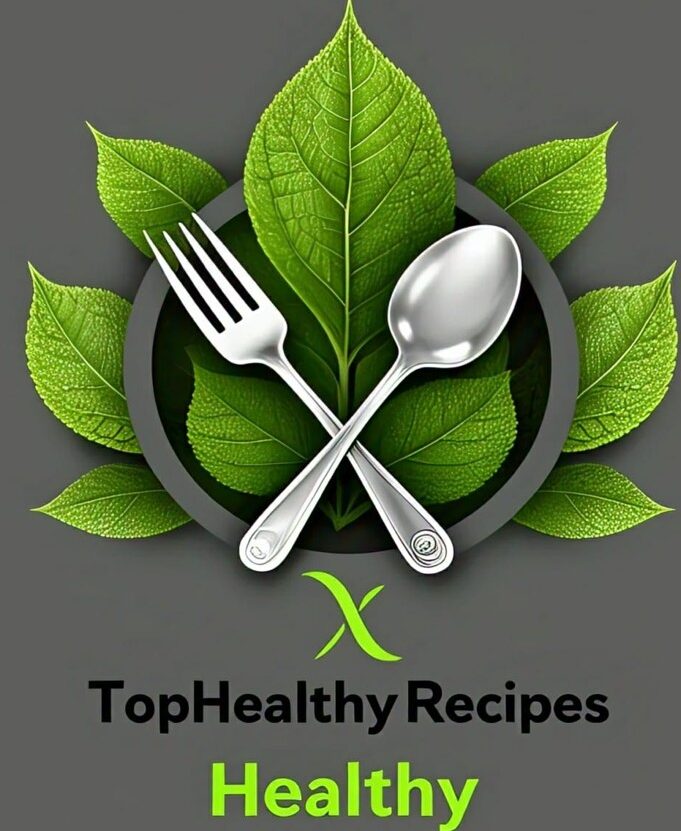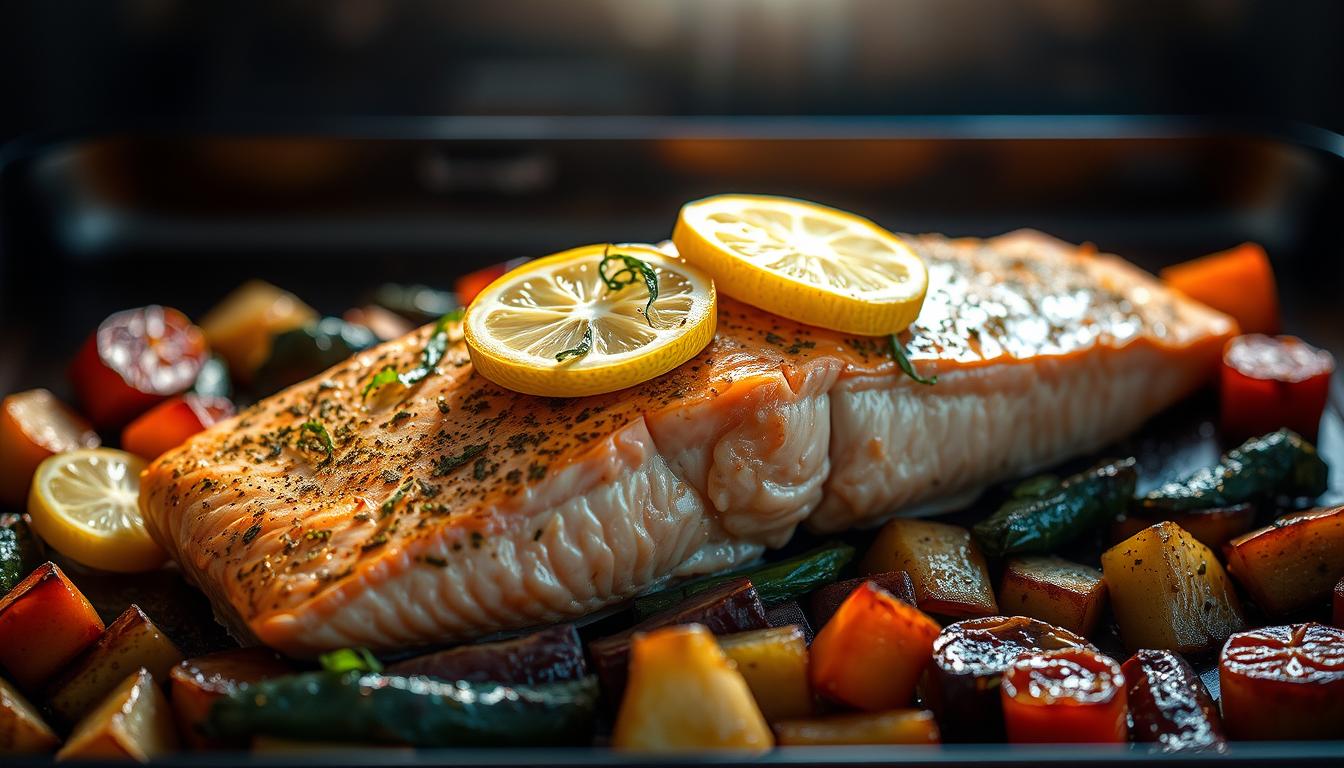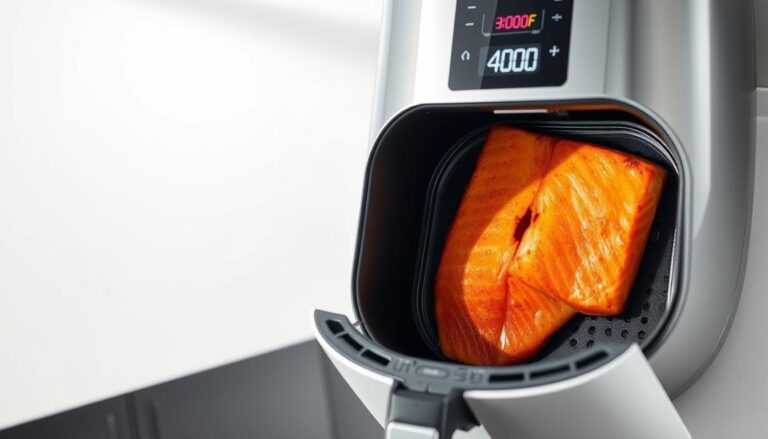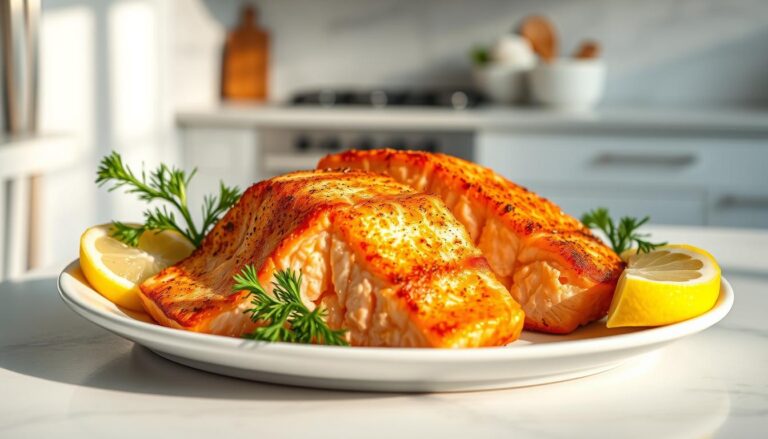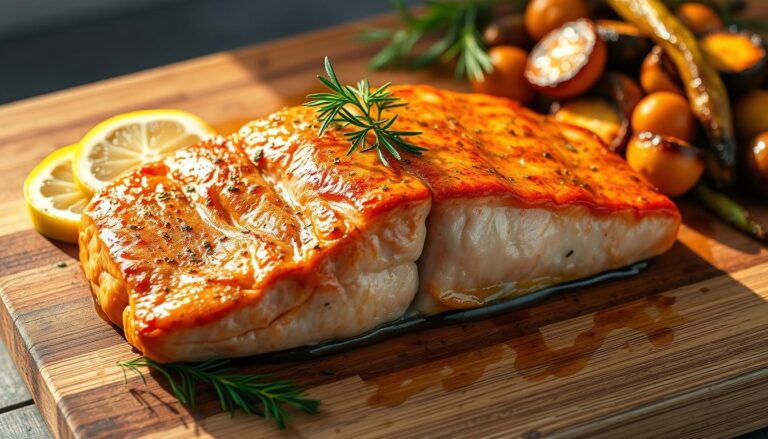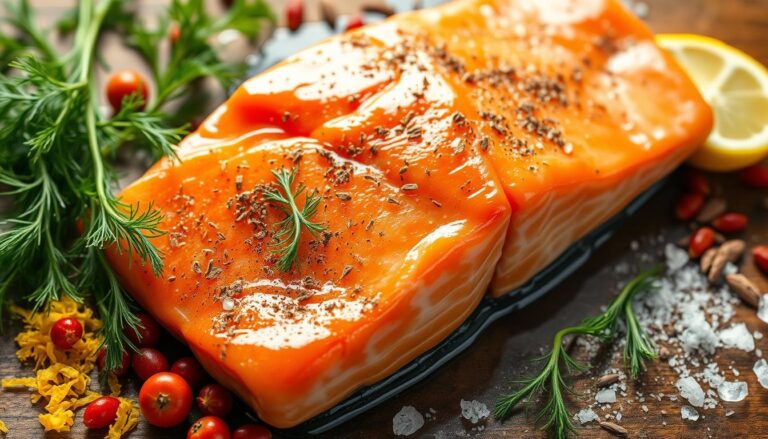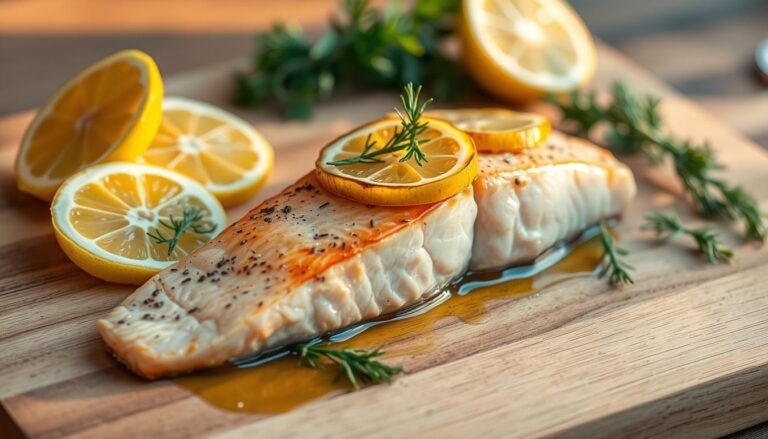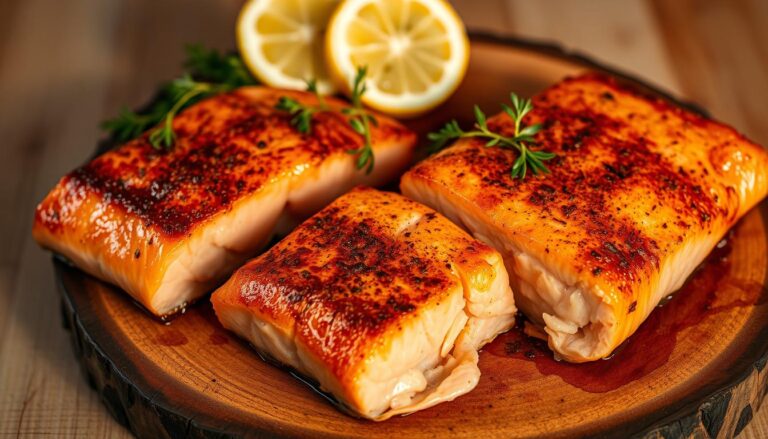How to make baked salmon in the oven
Table of Contents
How to make baked salmon in the oven
Looking for a quick, healthy, and delicious meal? This easy baked salmon recipe is perfect for busy weeknights or even entertaining guests. With just 5 minutes of prep time, you can create a dish that’s both flavorful and nutritious.
This recipe is incredibly adaptable. Pair it with your favorite side dishes for a casual dinner or dress it up for special occasions. The dish is packed with high-quality protein and omega-3 fatty acids, making it a heart-healthy choice. Using olive oil and simple seasonings like garlic, paprika, and brown sugar enhances the natural flavors without overwhelming them.
Even if you’re new to cooking, this recipe is foolproof. You’ll learn how to season the fish, bake it in foil or parchment paper, and check for doneness with a thermometer. For sustainability, consider using wild-caught Bristol Bay sockeye salmon. It’s a small step that makes a big difference.
Key Takeaways
- Prep time is just 5 minutes, making it ideal for busy schedules.
- Perfect for casual dinners or entertaining with side dishes.
- Rich in protein, omega-3s, and heart-healthy olive oil.
- Beginner-friendly with no advanced cooking skills required.
- Simple seasonings like garlic and paprika enhance natural flavors.
- Opt for wild-caught Bristol Bay sockeye salmon for sustainability.
- Check doneness with a thermometer for perfect results.
Why Baked Salmon is a Weeknight Favorite
Need a hassle-free dinner idea for busy evenings? This dish is a lifesaver. With just 5 minutes of prep time, you can pop it in the oven and focus on other tasks. It’s perfect for those hectic weeknights when you’re juggling work, family, and everything in between.
Compared to takeout, this meal is healthier, cheaper, and customizable. You can use pantry staples like garlic, paprika, and honey to enhance the flavor. Plus, cooking with foil or parchment paper locks in moisture, ensuring it stays tender even if you’re distracted.
Leftovers are just as versatile. Use them in salads, pasta, or sandwiches for a quick and healthy lunch the next day. As one reader shared, “This recipe has millions of views and glowing reviews for a reason—it’s a game-changer!”
Kids love it too, thanks to the subtle sweetness from brown sugar or honey. It’s a family-friendly option that’s both nutritious and delicious. Whether it’s a casual weeknight or a last-minute gathering, this dish never disappoints.
“This recipe has millions of views and glowing reviews for a reason—it’s a game-changer!”
| Feature | Benefit |
|---|---|
| 5-minute prep | Saves time for busy schedules |
| Customizable | Use pantry staples for flavor |
| Leftover-friendly | Versatile for next-day meals |
| Kid-approved | Subtle sweetness appeals to kids |
Ingredients You’ll Need for Baked Salmon
Ready to gather the essentials for a flavorful dish? The right ingredients ensure your meal is both delicious and nutritious. Here’s what you’ll need to get started.
For this recipe, you’ll need a salmon fillet, preferably skin-on. The skin helps retain moisture during cooking and makes cleanup easier. Other key items include olive oil, brown sugar, paprika, garlic powder, salt, and pepper. These simple seasonings enhance the natural flavors without overpowering them.

Choosing the Right Salmon
When selecting your fillet, consider the difference between wild and farmed options. Wild-caught varieties, like Bristol Bay sockeye, are leaner and richer in protein and omega-3s. They’re also more sustainable, as recommended by the Monterey Bay Aquarium’s Seafood Watch.
Farmed salmon tends to have a higher fat content, which can affect texture and flavor. If you’re opting for frozen fillets, ensure they’re additive-free for the best results. Both fresh and frozen options work well, so choose based on availability and preference.
Need substitutions? Swap brown sugar for honey or use ghee instead of olive oil for a dairy-free alternative. These small changes can tailor the recipe to your dietary needs without compromising taste.
How to Prepare the Salmon for Baking
Want to make your cooking process smoother and more efficient? Proper prep ensures your dish turns out flavorful and hassle-free. Start by patting the fillets dry with a paper towel. This step helps the seasonings stick better and prevents excess moisture during cooking.
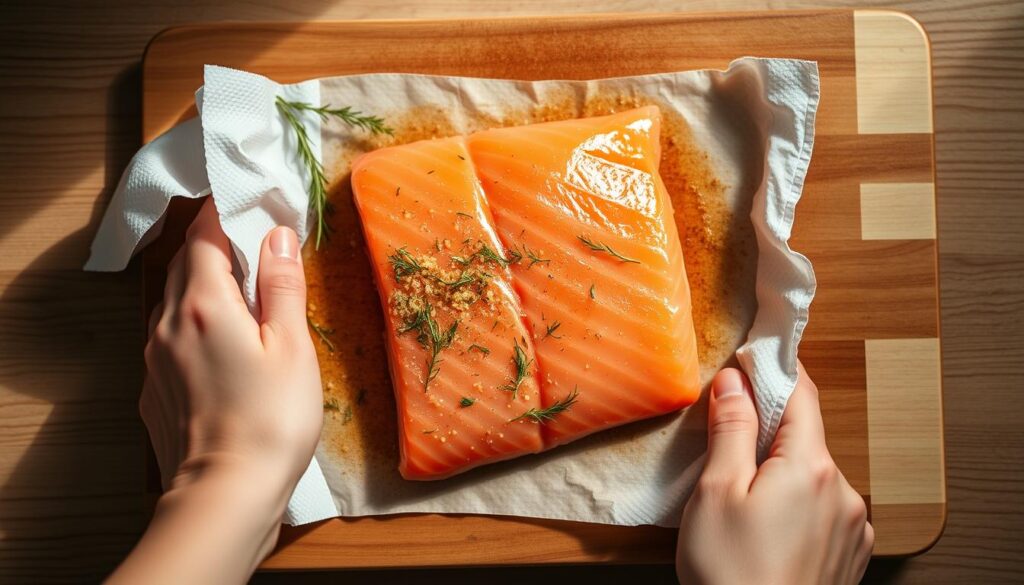
Next, mix your spices in a small bowl. Combine garlic powder, paprika, salt, and pepper for a simple yet delicious blend. Using garlic powder instead of fresh cloves ensures even coverage without clumping. Brush the fillets generously with olive oil to lock in moisture and enhance the flavor.
Seasoning the Salmon
Once the fillets are prepped, sprinkle the spice mix evenly over both sides. For extra richness, add optional ingredients like lemon slices, fresh dill, or a pat of butter. These additions can elevate the dish without complicating the process.
Line your baking sheet with foil or parchment paper to prevent sticking and simplify cleanup. Arrange the fillets on the lined tray, ensuring they’re not overcrowded. Overheating can cause albumin (a white protein) to ooze out, so keep the temperature moderate for the best results.
| Step | Tip |
|---|---|
| Pat fillets dry | Helps seasonings stick better |
| Mix spices | Use garlic powder for even coverage |
| Brush with olive oil | Locks in moisture and flavor |
| Line with foil | Prevents sticking and simplifies cleanup |
Baking the Salmon to Perfection
Achieving perfectly cooked fish is easier than you think. The key lies in controlling the temperature and timing. Preheat your oven to 375°F for whole sides or 400°F for individual fillets. This ensures even cooking and a tender result.

Cook time varies based on thickness. A 1-inch fillet typically takes 12-15 minutes, while a 1.5-inch fillet may need 15-20 minutes. Always check the thickest part to avoid undercooking or overcooking.
How to Tell When the Salmon is Done
Using an instant-read thermometer is the most accurate method. The FDA recommends an internal temperature of 145°F for safety. For medium-rare, aim for 140°F. Insert the thermometer into the thickest part for an accurate reading.
Visual cues also help. The flesh should turn opaque and flake easily with a fork. If you’ve added lemon slices, look for bubbling juice as a sign it’s ready. These indicators ensure your dish is perfectly cooked.
Be cautious—fish progresses from underdone to overdone quickly. Overcooking can dry it out, so monitor the temperature closely. With these tips, you’ll master the art of knowing when your dish is salmon done.
Tips for Baking Salmon in Foil or Parchment Paper
Wondering how to keep your fish moist and flavorful? Using foil or parchment paper is the secret. Both methods lock in moisture, making your dish tender and delicious. But which one should you choose?
Foil is a fantastic “flavor incubator.” It conducts heat evenly, ensuring your fish cooks thoroughly. It’s also great for trapping steam, which keeps the fish moist. On the other hand, parchment paper is nonstick and avoids any metallic taste. It’s perfect for those who prefer a neutral cooking surface.
To create a packet, fold the edges tightly to seal in the steam. This technique infuses flavors and keeps the fish tender. Add veggies like asparagus or zucchini to the packet for a complete meal. It’s a time-saver and ensures everything cooks together.
Here’s a pro tip: Mist the foil with oil to prevent sticking. Even with parchment paper, a light coating of oil ensures easy removal. For a crispy top, broil foil-free fillets for 3 minutes after baking. It adds a delightful texture to your dish.
| Method | Benefits |
|---|---|
| Foil | Even heat conduction, traps steam, flavor incubator |
| Parchment Paper | Nonstick, no metallic taste, easy cleanup |
Both methods are beginner-friendly and guarantee moist, flavorful results. Whether you choose foil or parchment paper, you’ll enjoy a hassle-free cooking experience with minimal cleanup.
Variations of Baked Salmon Recipes
Want to explore new flavors with your next meal? These salmon recipes offer a range of tastes to suit any palate. From zesty lemon to rich garlic butter, there’s something for everyone. Each variation is easy to prepare and packed with flavor.
Lemon and Dill
For a fresh and tangy twist, try the lemon and dill variation. Combine fresh dill sprigs with lemon zest for a bright, herbaceous flavor. Pair it with quinoa or roasted potatoes for a complete meal. This recipe is perfect for those who love a light and refreshing dish.
Garlic Butter
Indulge in the rich taste of garlic butter. Melted butter mixed with minced garlic creates a savory glaze. Baste the fillets mid-bake for a caramelized finish. This variation is ideal for those who enjoy a buttery, aromatic flavor.
Spicy
Add some heat with a spicy rub. Use chili powder, cumin, and smoked paprika for a bold kick. This variation is great for those who crave a bit of spice in their meals. Serve with a cooling side like cucumber salad to balance the heat.
Asian-Inspired
For an umami-packed option, try the Asian-inspired glaze. Combine soy sauce, ginger, and honey for a sweet and savory mix. This recipe is perfect for those who enjoy bold, complex flavors.
Mediterranean
Bring a taste of the Mediterranean to your table. Use Kalamata olives, cherry tomatoes, and feta crumbles for a vibrant dish. This variation is ideal for those who love fresh, tangy flavors.
| Variation | Key Ingredients |
|---|---|
| Lemon and Dill | Fresh dill, lemon zest |
| Garlic Butter | Melted butter, minced garlic |
| Spicy | Chili powder, cumin, smoked paprika |
| Asian-Inspired | Soy sauce, ginger, honey |
| Mediterranean | Kalamata olives, cherry tomatoes, feta |
The Health Benefits of Baked Salmon
Curious about why this dish is a nutritional powerhouse? Packed with essential nutrients, it’s a meal that supports overall well-being. A 6-ounce serving delivers 34 grams of protein and just 180 calories, making it a lean yet filling option.
One of its standout features is its high omega-3 content. These fatty acids are known to reduce inflammation, support brain health, and promote heart health. Regular consumption can lower the risk of chronic diseases, making it a smart choice for long-term wellness.
This dish is also rich in selenium, a mineral with cancer-fighting properties. It’s a great source of vitamin D, which is essential for bone health and immune function. Unlike fried options, baking preserves these nutrients without adding extra fat.
For pregnant women, the high levels of B12 and iron support fetal development and prevent anemia. Athletes benefit from its protein content, which aids muscle repair and recovery. Whether you’re looking to boost your energy or support a healthy lifestyle, this meal has you covered.
How to Store and Reheat Leftover Baked Salmon
Have leftovers from your last meal and unsure how to handle them? Proper storage and reheating ensure your dish stays fresh and delicious. Here’s how to make the most of your leftover fish.
To store it, place the fillets in an airtight container. Keep them in the fridge for up to 3-4 days. Avoid freezing, as it can alter the texture and make the fish less enjoyable. This method keeps your meal ready for quick use.
When it’s time to reheat, choose a method that preserves moisture. Use a skillet with a splash of water to create steam, or opt for the microwave at low power in 30-second intervals. Both methods prevent the fish from drying out.
Repurpose your leftover fish creatively. Flake it into scrambled eggs, toss it with pasta, or use it as a topping for a fresh salad. These ideas make your meal versatile and exciting.
Be cautious not to overheat. Aim for an internal temperature of 125-130°F to keep the fish tender. Over-reheating can dry it out, so monitor closely for the best results.
| Step | Tip |
|---|---|
| Store in airtight container | Keeps fish fresh for 3-4 days |
| Reheat with water steam | Prevents drying out |
| Repurpose creatively | Use in eggs, pasta, or salads |
| Avoid over-reheating | Target 125-130°F internal temp |
Conclusion: Mastering the Art of Baked Salmon
Ready to elevate your cooking skills with a simple yet impressive dish? This baked salmon recipe is both easy and delicious, making it a go-to for any meal. With precise baking temperatures and the benefits of foil or parchment paper, you’ll achieve consistent results every time.
Don’t be afraid to experiment with herb blends and marinades. Whether it’s a casual dinner or a special occasion, this dish adapts to your creativity. Always check the internal temperature to ensure perfection.
Share your culinary creations on social media using #themodernproper or #downshiftology. For more inspiration, explore related recipes like grilled salmon or salmon patties. Happy cooking!
FAQ
how long to bake salmon
how long to bake salmon at 400?
how to bake salmon?
how to bake salmon in the oven
how long to bake salmon at 350?
Why is baked salmon a great weeknight dinner option?
What type of salmon should I use for baking?
How do I season salmon for baking?
How can I tell when the salmon is done cooking?
Should I bake salmon in foil or parchment paper?
What are some popular baked salmon recipe variations?
What are the health benefits of eating baked salmon?
How should I store and reheat leftover baked salmon?
For more cooking tips, stay connected with us. We also recommend the cookbook Skinnytaste Simple: Easy, Healthy Recipes with 7 Ingredients or Fewer
For more Recipes about Salmon
